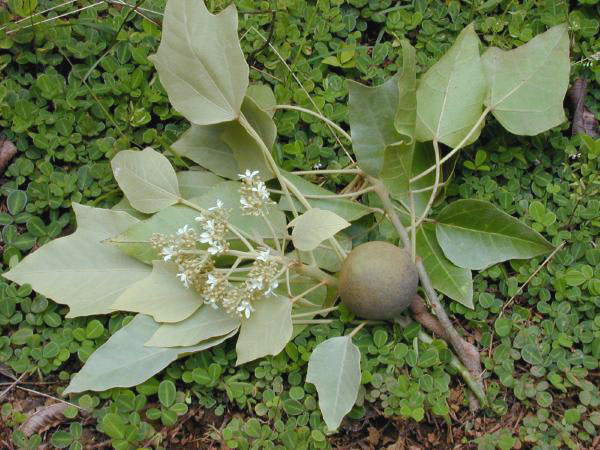- Candlenut
Taxobox
name = Candlenut

image_width = 240px
image_caption = Candlenut ("Aleurites moluccana") foliage, flowers, and nut
regnum =Plant ae
divisio =Magnoliophyta
classis =Magnoliopsida
ordo =Malpighiales
familia =Euphorbiaceae
genus = "Aleurites "
species = "A. moluccana"
binomial = "Aleurites moluccana"
binomial_authority = (L.) Willd.The Candlenut ("Aleurites moluccana"), is a
tree in the familyEuphorbiaceae , also known as Candleberry, Indian walnut, Kemiri, Varnish tree or Kukui nut tree.Its native range is impossible to establish precisely because of early spread by humans, and the tree is now widely distributed in the New and Old World tropics. It grows to a height of 15-25 m, with wide spreading or pendulous branches. The leaves are pale green, simple and ovate, or trilobed or rarely 5-lobed, with an acute apex, 10–20 cm long. The nut is round, 4–6 cm in diameter; the
seed inside has a very hard seed coat and a high oil content, which allows its use as a candle (see below), hence its name.Uses
*The candle nut is similar (though "rougher") in flavor and texture to the
macadamia nut, which has a similarly high oil content. It is mildly toxic when raw.Fact|date=May 2008
*The nut is often used cooked inIndonesian cuisine and Malaysian, where it is called "kemiri" in Indonesian or "buah keras" in Malay. In Java ofIndonesia , it is used to make a thick sauce which is eaten with vegetables and rice.
*Several parts of the plant have been used in traditional medicine in most of the areas where it is native. The oil is an irritant andpurgative and sometimes used likecastor oil . It is also used as a hair stimulant or additive to hair treatment systems. The seed kernels have alaxative effect. InJapan itsbark has been used ontumor s. InSumatra , pounded seeds, burned with charcoal, are applied around the navel forcostiveness . In Malaya, the pulped kernels or boiled leaves are used in poultices for headache, fevers, ulcers, swollen joints, andgonorrhea . In Java, the bark is used for bloodydiarrhea ordysentery .
*In ancient Hawaiokinai, the nuts, named "kukui" were burned to provide light. The nuts were strung in a row on a palm leaf midrib, lit one end, and burned one by one every 15 minutes or so. This led to their use as a measure of time. One could instruct someone to return home before the second nut burned out.
*InTonga , still nowadays, ripe nuts, named "tuitui" are pounded into a paste, "tukilamulamu", used as soap or shampoo.
*Candle nuts are also roasted and mixed into a paste with salt to form a Hawaiian condiment known as "inamona". Inamona is a key ingredient in traditional Hawaiian "poke". It's the Hawaiian state tree. [ [http://www.50states.com/tree/hawaii.htm State tree of Hawaii] ]
* Dead wood of candlenut is eaten by a larva of acoleoptera called "Agrionome fairmairei". This larva is eaten by some people.Modern cultivation is mostly for the oil. In plantations, each tree will produce 30–80 kg of nuts, and the nuts yield 15 to 20% of their weight in oil. Most of the oil is used locally rather than figuring in international trade.
Mythology
In Hawaiokinai the Candlenut tree is a symbol of enlightenment, protection and peace. Candlenut was considered to be the body form of
Kamapua'a , the pig god. One of the legends told about a woman who, despite her best efforts to please her husband, was routinely beaten. Finally, the husband beat her to death and buried her under a kukui tree. Being a kind and just woman, she was given new life, and the husband was eventually killed.Fact|date=May 2008References
External links
* [http://www.hear.org/pier/species/aleurites_moluccana.htm Pacific Island Ecosystems at Risk factsheet]
* [http://www.oilsofaloha.com Oils of Aloha] — A Hawaii company producing kukui and macadamia nut products, their website plays host to much information about both nuts.
Wikimedia Foundation. 2010.
